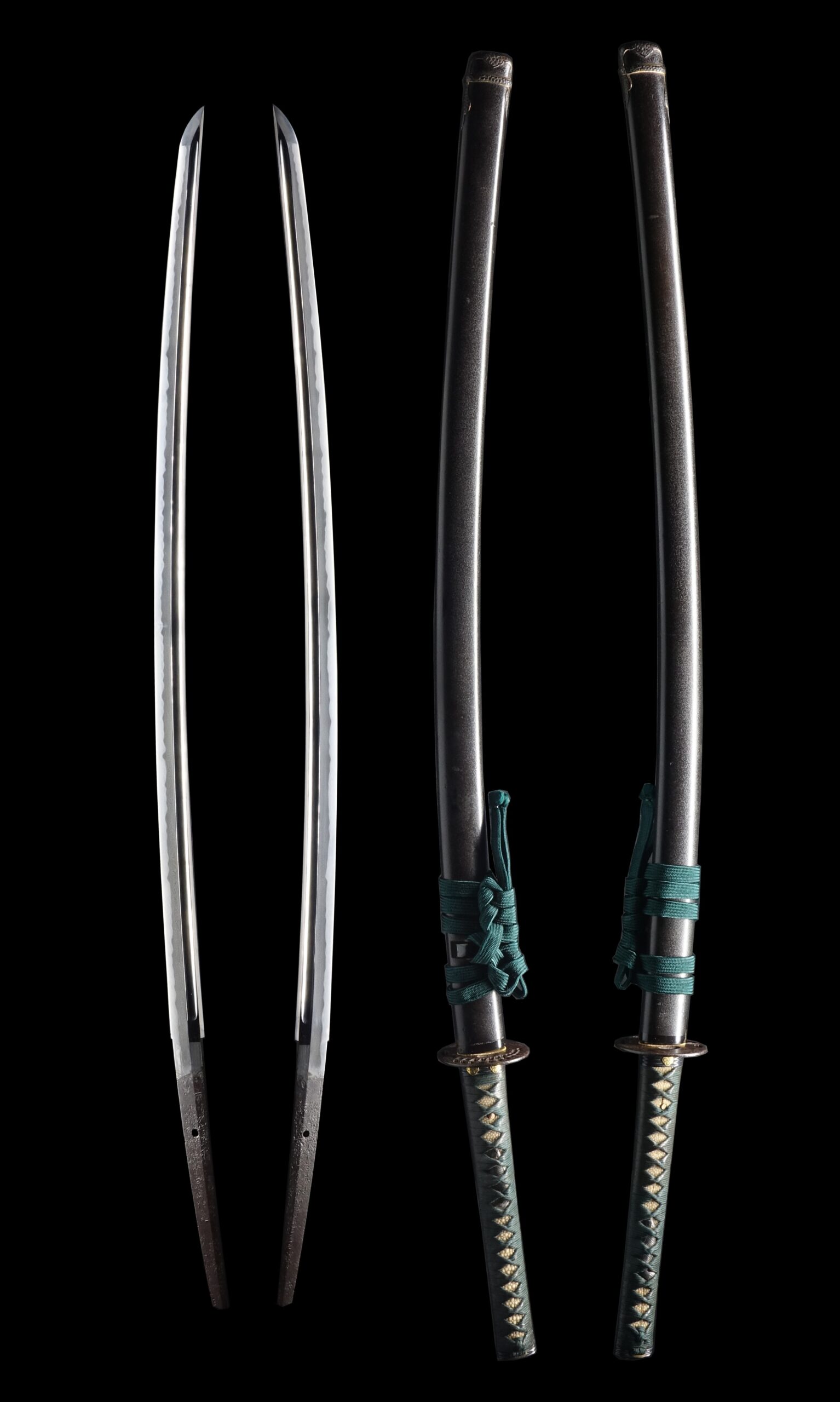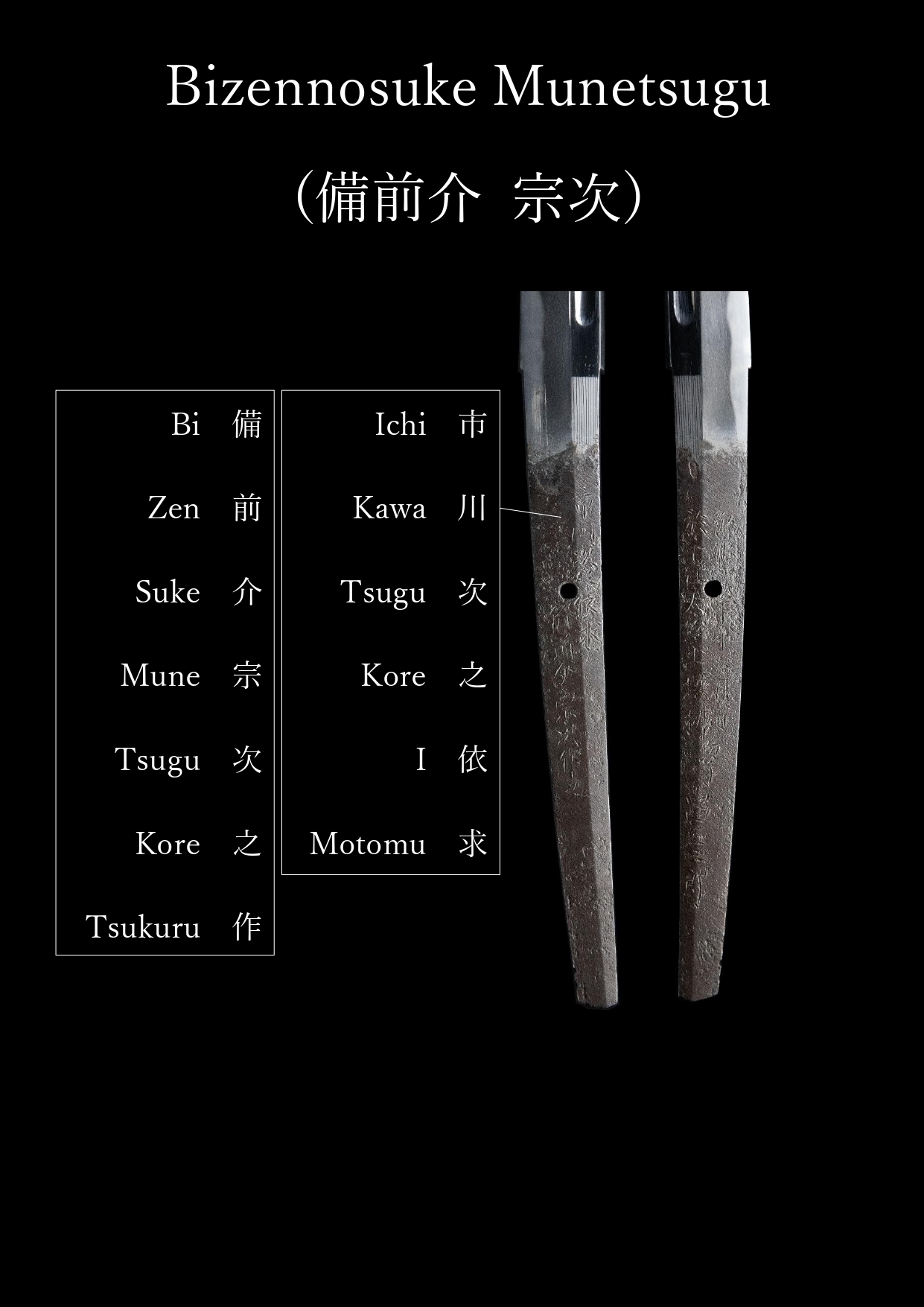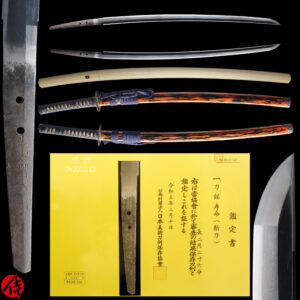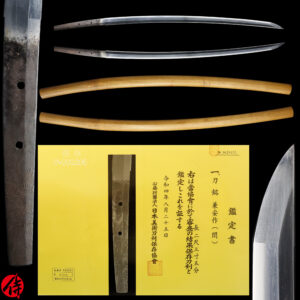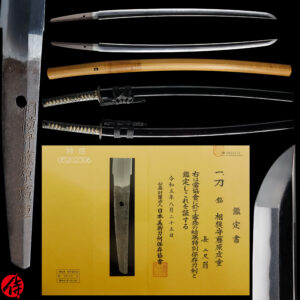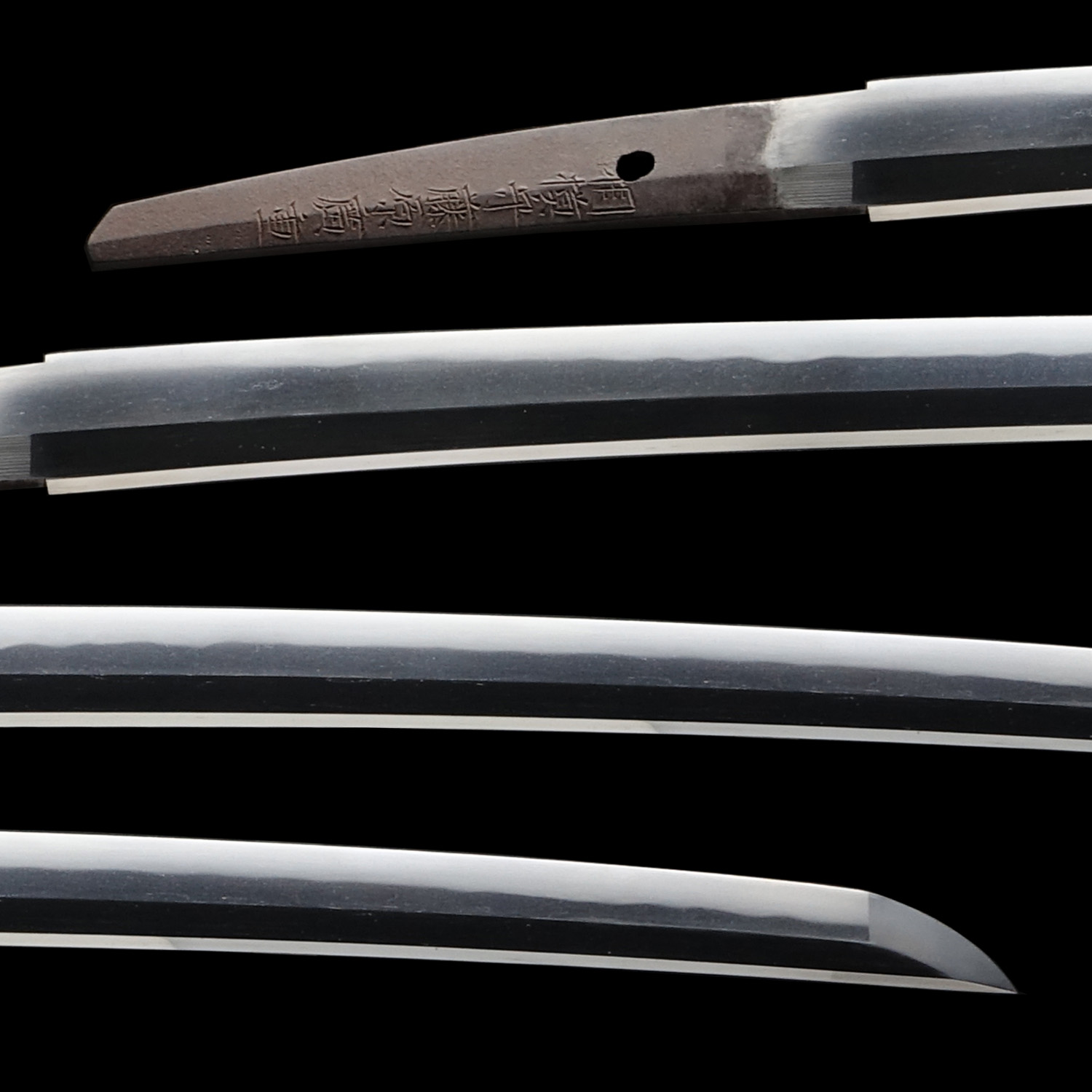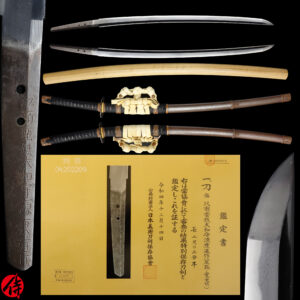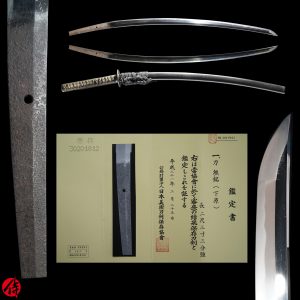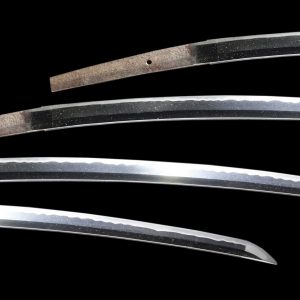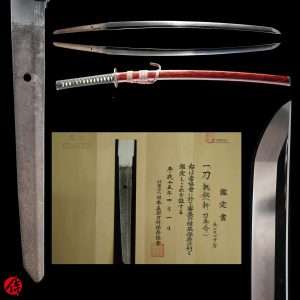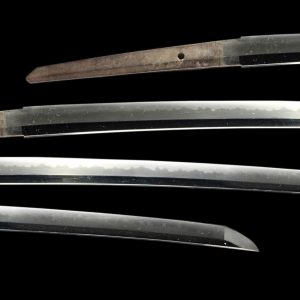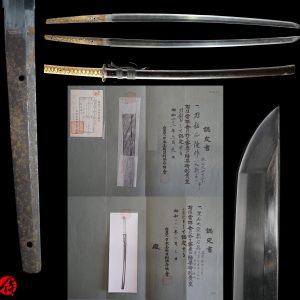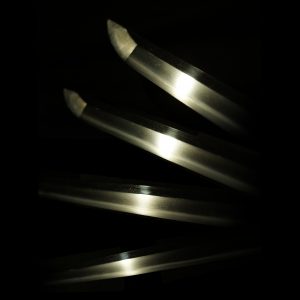Antique Japanese Sword Katana Tameshigiri Mei Signed by Bizen no Suke Munetsugu with Tokubetsu Hozon Certificate
【Description】
Summary
This blade was signed by Bizen no Suke Fujiwara Munetsugu(備前助藤原宗次) in the third year of the Kouka era (1846: The end of the Edo period). He is also known as Koyama Munetsugu (固山宗次).
His given name was Koyama Sobei (固山宗兵衛). He was born as the third son of Koyama Munehira(固山宗平) in Shirakawa domain in Mutsu province (today’s Fukushima prefecture) in 1802. It is said that he learned the sword-forging technique from Kato Tsunahide(加藤綱英) first and was also an apprentice of Chounsai Tsunatoshi (長運斎綱俊), a younger brother of Tsunahide to improve his craftsmanship.
Munetsugu first served Shirakawa Matsudaira(白河松平家) clan as Hanko(藩工:retained swordsmith). After Matsudaira clan was ordered to relocate to Kuwana domain(Today’s Mie prefecture), Munetsugu became a swordsmith for that domain. However, he eventually settled in Edo city from the second year of the Koka era (1845) by working for Matsudaira clan of the Kuwana family. Because of these historical records, we believe this blade was made in Edo city.
Munetsugu received an honorable title of Bizen no Suke(備前助) in the same year when he moved to Edo city(1845). His work reflects Bizen Den, one of the five most traditional Japanese sword-forging techniques (五箇伝). He was excellent at forging blades with Choji Gunome Midare tempering line, one of the most noticeable characteristics of Bizen Tradition. He was active in sword-forging during 1830-1870. He is arguably the finest smith working in the Bizen tradition at the end of the Edo period.
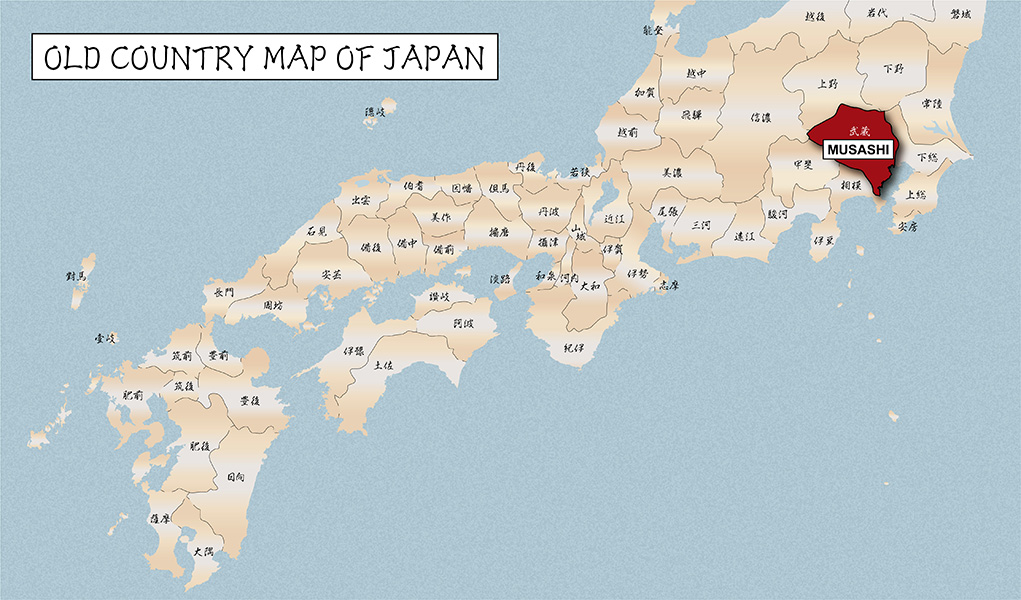
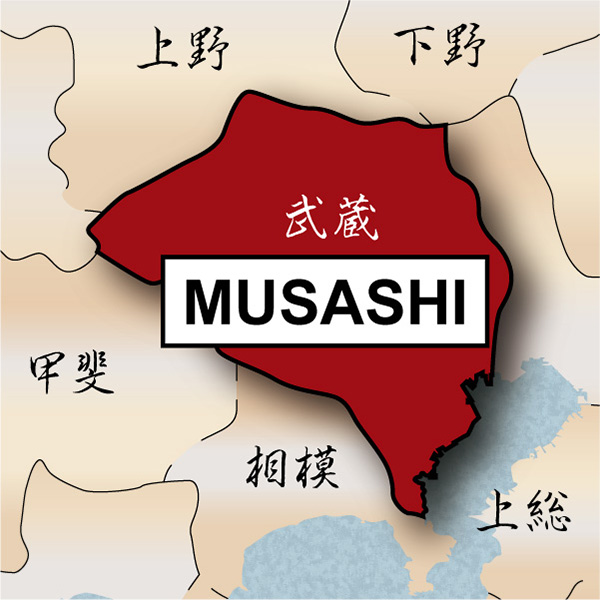
Munetsugu was one of the most popular and famous swordsmiths in Edo city during the end Edo period. His swords have been known for their sharpness. There are many records of his swords passing the test cutting process (Tameshigiri). This blade is one of them. *We will explain about the detail of the test cutting signature in the later paragraphs.
In his career, he pursued and researched sword-forging to make extremely sharp blades that were practically effective in battles to meet up the demands of the clan. There was a record of him studying to improve the sharpness of his swords from the seventh-gen Yamada Asaemon, also known as Yamada Gosaburo or Yamada Yoshitoshi. Munetsugu often received orders from feudal lords or famous figures during the end of the Edo period.
Munetsugu has been highly regarded among Japanese sword collectors and experts. It is said that his level of craftsmanship is close to or at least equivalent to Sushinshi Masahide, Naotane and other very selected swordsmiths from the end of the Edo period.
Tameshigiri (test cutting signature) conducted by Yamada Gosaburo
Based on the signature on the tang, it was used for Tamashigiri (test cutting). Yamada Gosaburo, the 7th-gen Yamada Asaemon, conducted test cutting. He was born in 1813 as the second son of Goto Gozaemon, a Samurai serving the Nimi domain (today’s Okayama prefecture).
He became a son-in-law who was taken into the Yamada family and changed his sir name to Yamada. Yamada family served the Edo government as an Otameshi Goyo (御様御用), who checked the sharpness of the blades made for Shogun or high-class Samurai officials by conducting test cutting. The family was also in charge of executing inmates on death row. The first-gen Yamada Asaemon was active when Shogun Tokugawa Yoshime took control of the government (1716〜1745). This position was passed down for generations. In most cases, one of the skilled apprentices took over the position by being adopted or becoming a son-in-law for the Yamada family. The seventh-gen was one of them.
The 7th-gen Asaemon, Yamada Gosaburo, was a reputable swordsman who conducted many Tameshigiri for high-ranked Samurai. It is said that Gosaburo executed Yoshida Shoin and other prominent members who were persecuted in the Ansei Purge (suppression of extremists who were against the Edo government at the end of the Edo period).
The dead bodies of inmates on death row were often subjected to Tameshigiri (test cutting). According to the tang statement, this blade cut through the shoulder to the chest area, which is considered the most hard-to-cut part of the human body. This statement proves this blade’s sharpness. Tata Dodan Barai (太々土壇拂) is the literal inscription on the tang. Tata refers to Scapula area. Dodan means the place for execution in ancient times in Japan. It also says that the Tameshigiri was conducted in the execution chamber in Kozukahara, Senjyu (Tokyo area). Since the Japanese sword was a practical weapon for Samurai, it was essential to prove the sharpness of one’s blade.
It is appraised as a Tokubetsu Hozon Token(特別保存刀剣) issued by NBTHK(Nihon Bijutsu Touken Hozon Kyokai:日本美術刀剣保存協会). This authentication paper was only given to authentic Japanese swords, especially well preserved and high quality with artistic value.
【 Blade】
Cutting Edge Length(Nagasa):75.7 cm (29.8 inches)
Curvature(Sori):1.85 cm (0.73 inches)

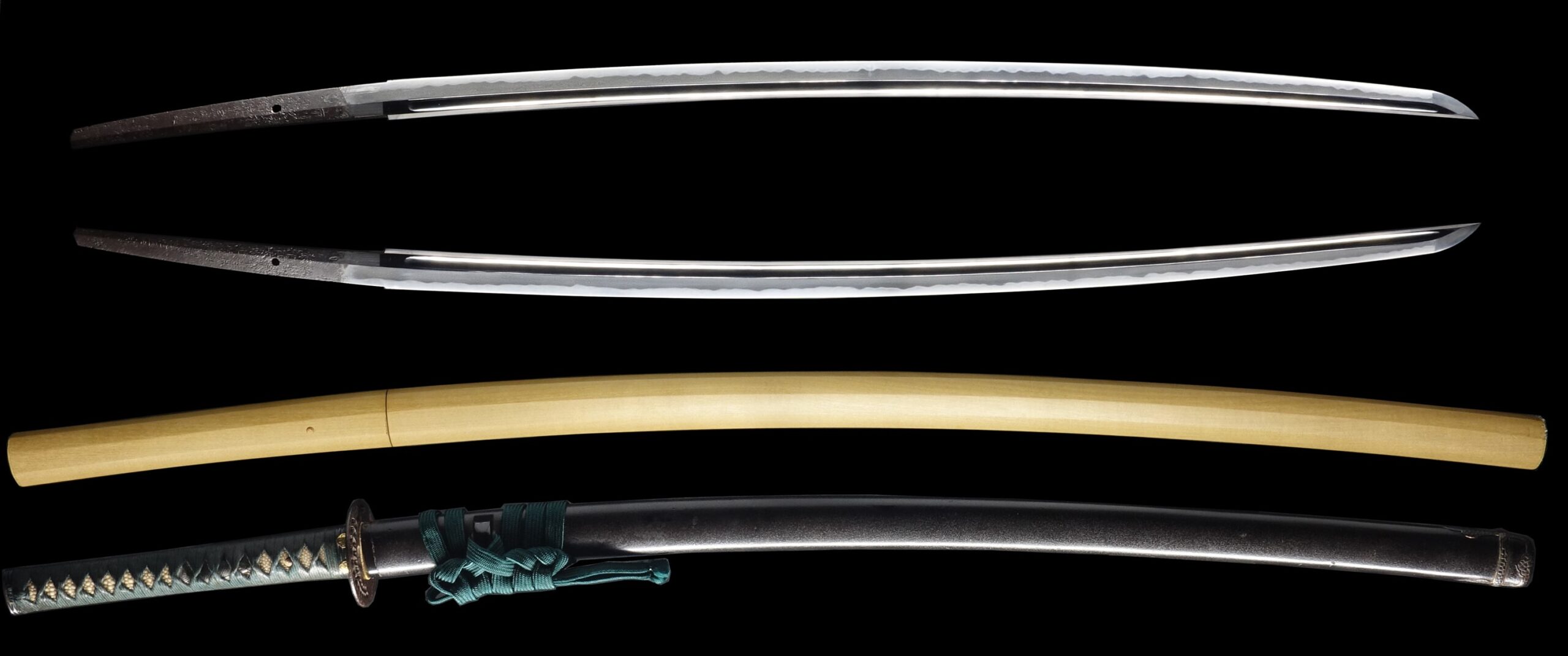
Hamon:
The crystalline structure which forms along the cutting edge of a blade as a result of the hardening process
Jimon(Jihada):
visible steel surface pattern created by folding and hammering during forging process

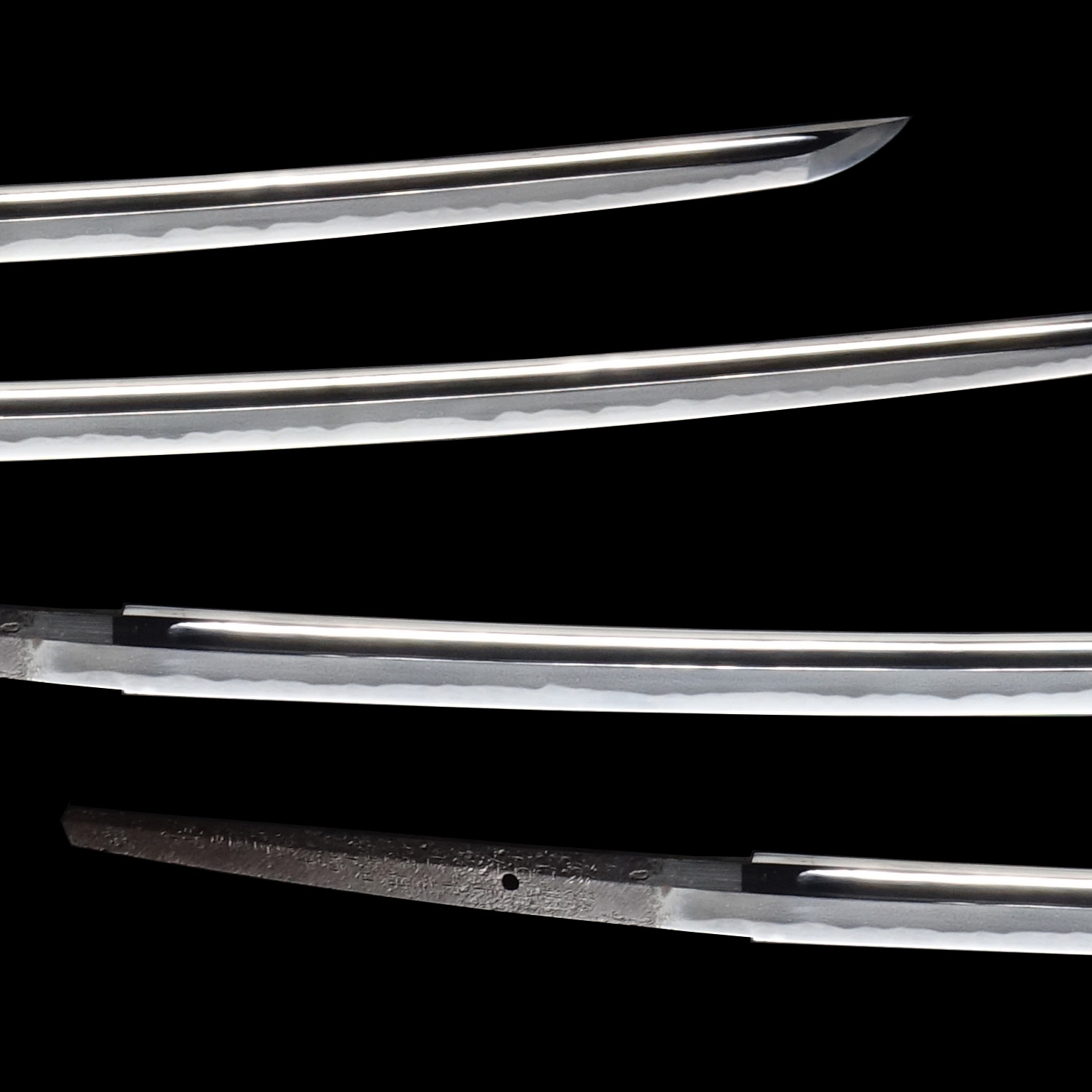
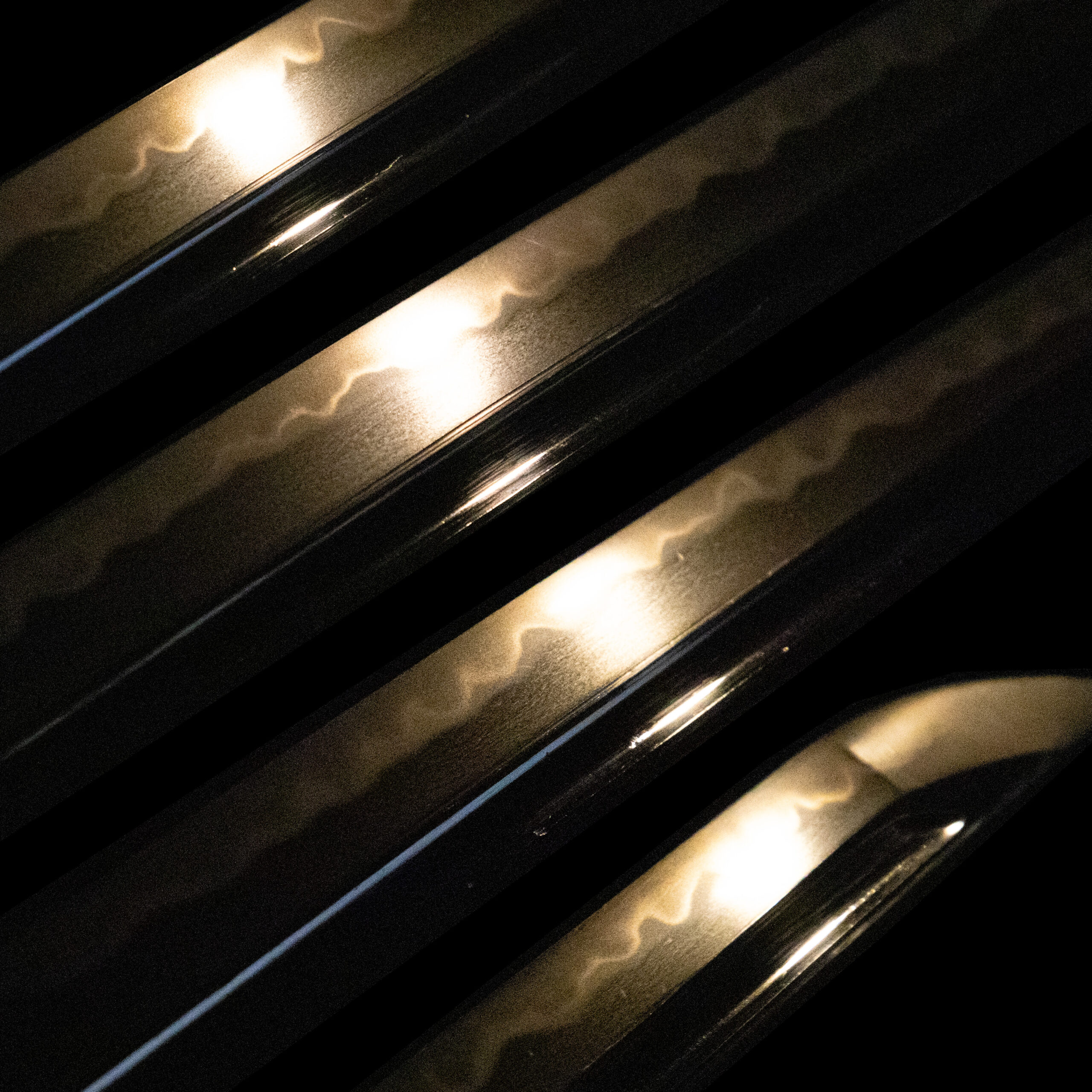
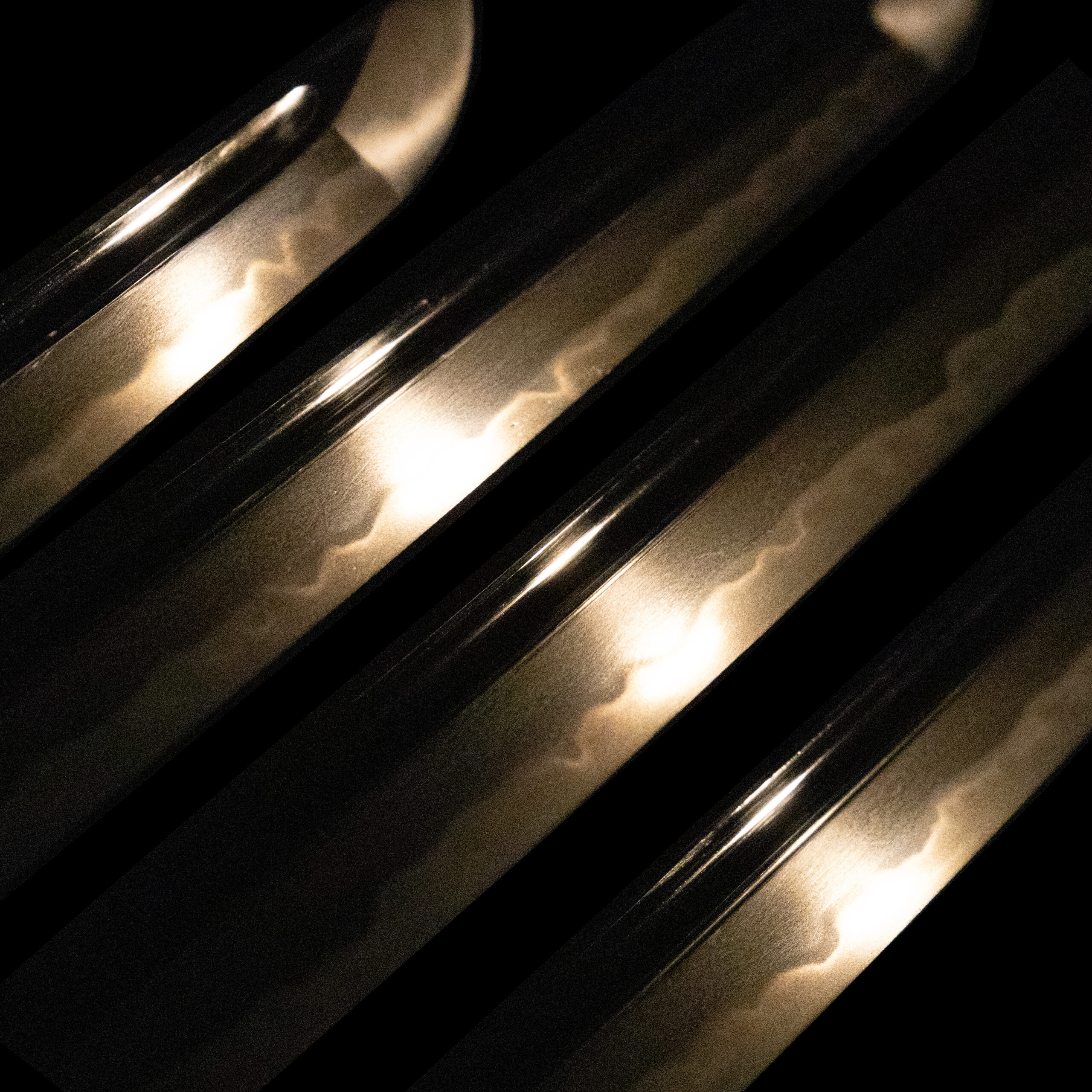
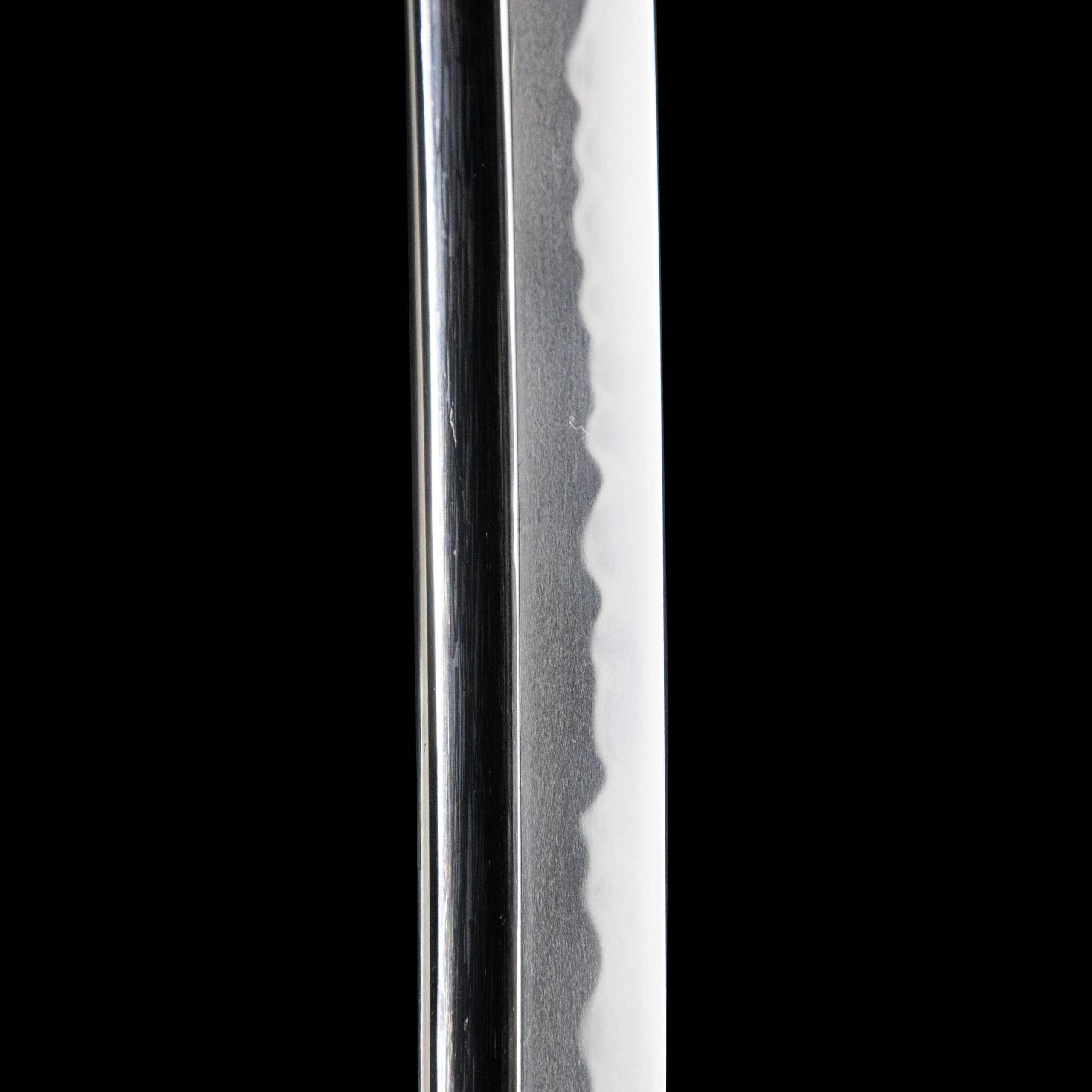
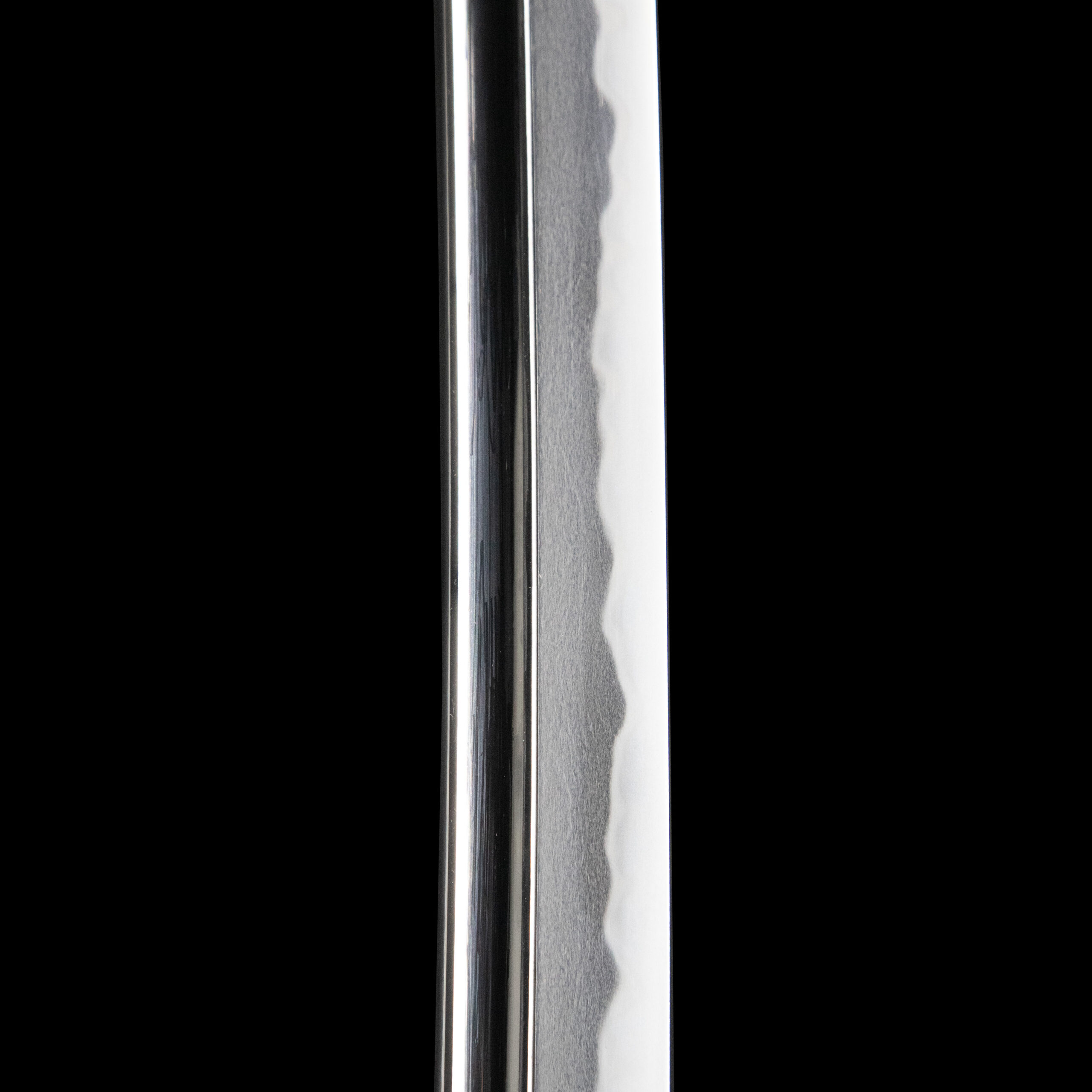
Kissaki: Kissaki is the tip of the Japanese sword.
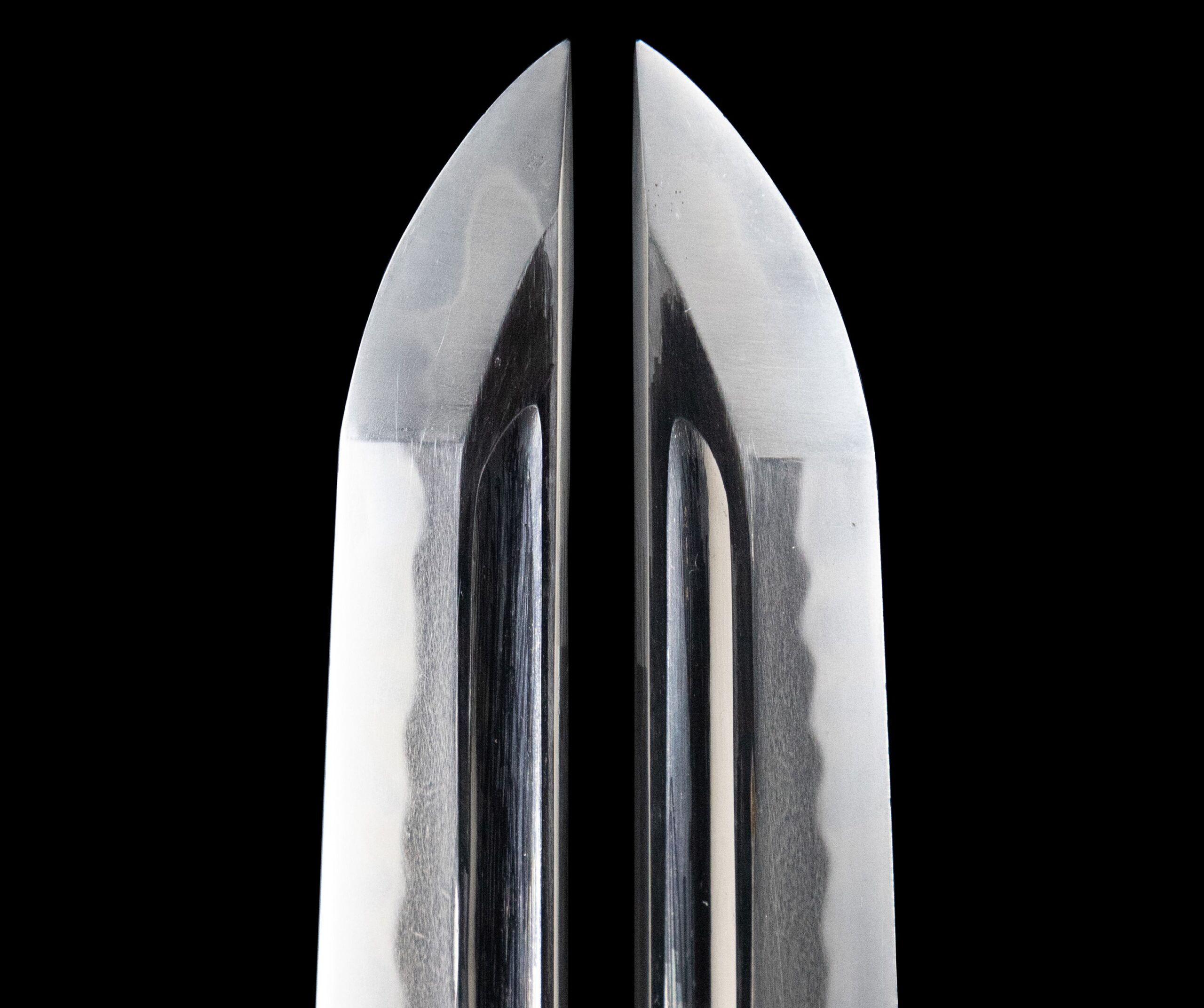
Nakago:Nakago is the tang of the Japanese sword.
Japanese swordsmiths left the black rust on the tang because it prevents red rust while the tang is in its handle. And the discoloration of the tang was created over time, and it is a great indicator for a Japanese sword specialist to estimate when the sword was forged.
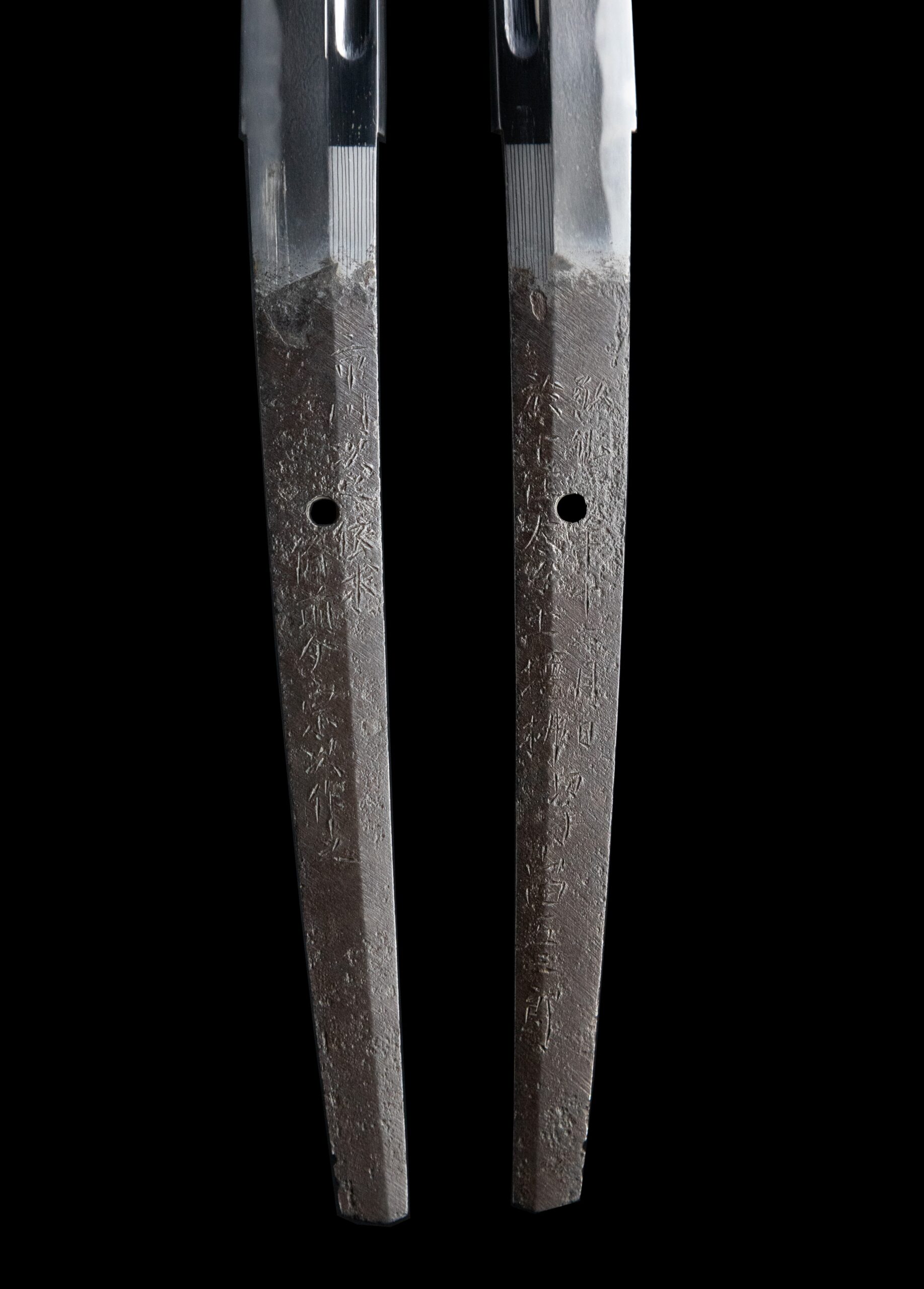
Koshirae: Koshirae is the mounting of the Japanese sword. There are several parts that consist of Koshirae such as Saya(Scabbard), Tsuka(Handle), Tsuba(Handguard).

Fuchi-Kashira:A pair of matching sword fittings that cover the upper and bottom parts of its sword hilt.
You would find the same golden marks are designed on this Fuchi Kashira. We believe these were applied here as family crests. One of this Katana’s former owners might have used this crest. We think this family crest is a kind of Sumikiri Kakuni Mokkou Mon (隅切り角に木瓜紋). It draws a cut corner around the Mokkou (木瓜) pattern. The Mokkou pattern is a design that has been depicted on a Mokou (帽額, cloths for decorating the hanging edge of the curtain and blinds). According to a theory, the Mokkou was named after the name of this silk cloth made of silk, “帽額 (Mokou).” Another view says that it was modeled after the cut end of a Boke (木瓜), a rose family plant. The Mokkou pattern is one of the five prominent family crests used in many houses. It is speculated that many people favored its good omen as a design to pray for the prosperity of descendants.
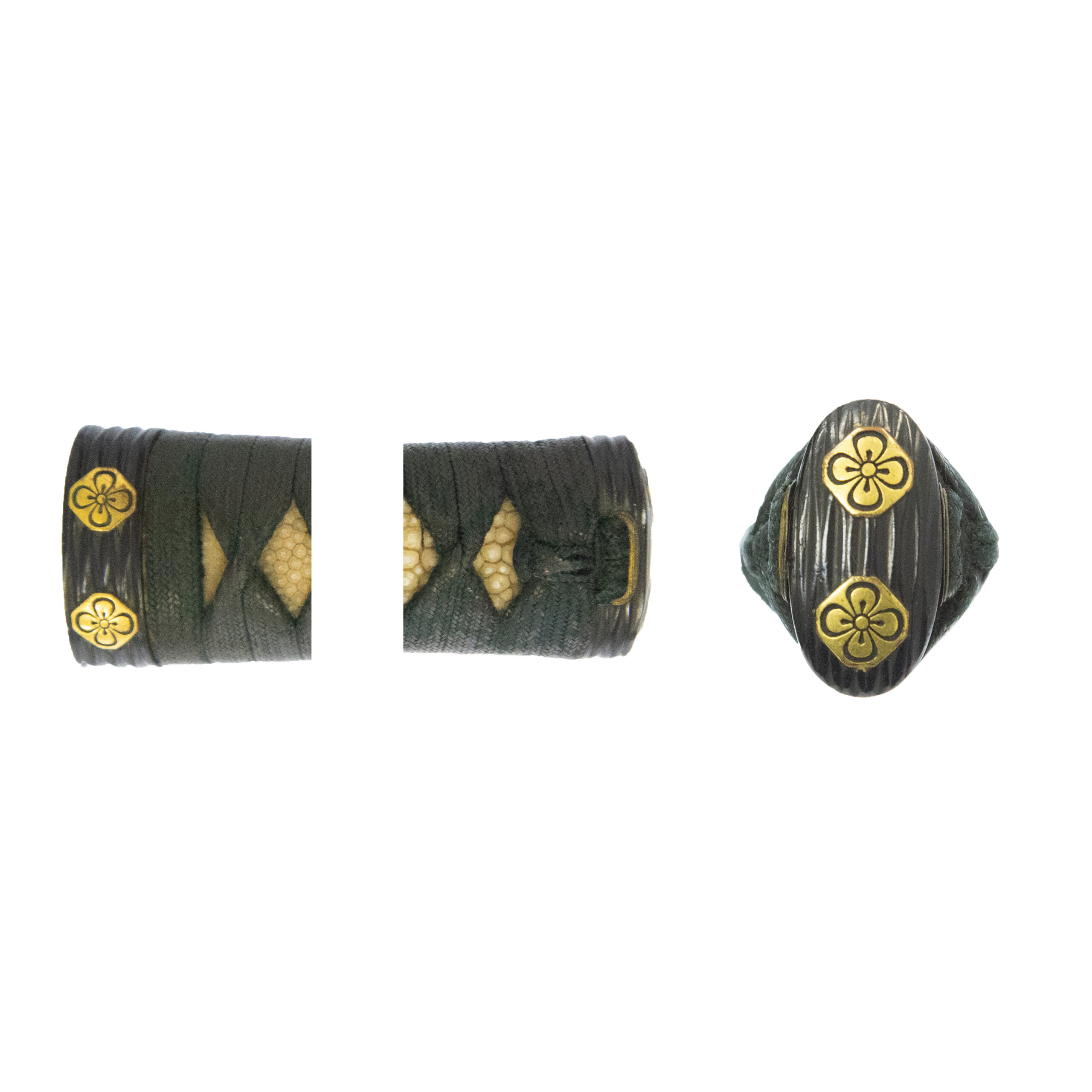
Tsuka and Menuki:Tsuka is the handle of the Japanese sword and Menuki is its decoration.
The figure of a Koi (鯉, domestic carp) is peeking from the gaps of the Tsukamaki thread. A Koi whose eye is gold is the motif of this Menuki. We could feel a forceful impression from their eyes, and they look elegant yet brave.
According to an ancient foreign story, many fishes tried to climb the waterfall called the Ryumon (竜門, dragon gate) in the rapid stream of the Yellow River. As a result, only Koi could have climbed up, become a dragon, and run through the sky. This is the reason why “Koi-no Taki Nobori” (鯉の滝昇り, domestic carp climbing waterfall) became a symbol of success in life. The Ryumon legend is associated with this story. This fish has been treated as the symbol of success in business and good health. By living confidently and making efforts, people hoped for their children to grow up to become magnificent people. Samurai families then might have used this fish motif wishing their sons to be promoted to high-ranked Samurai. The custom of decorating Koi-Nobori (鯉のぼり, domestic carp streamers) on Tango no Sekku (端午の節句, the Boy’s Festival) is said to have started in the middle of the Edo period. It is one of the traditional customs that has been passed down to the present day.
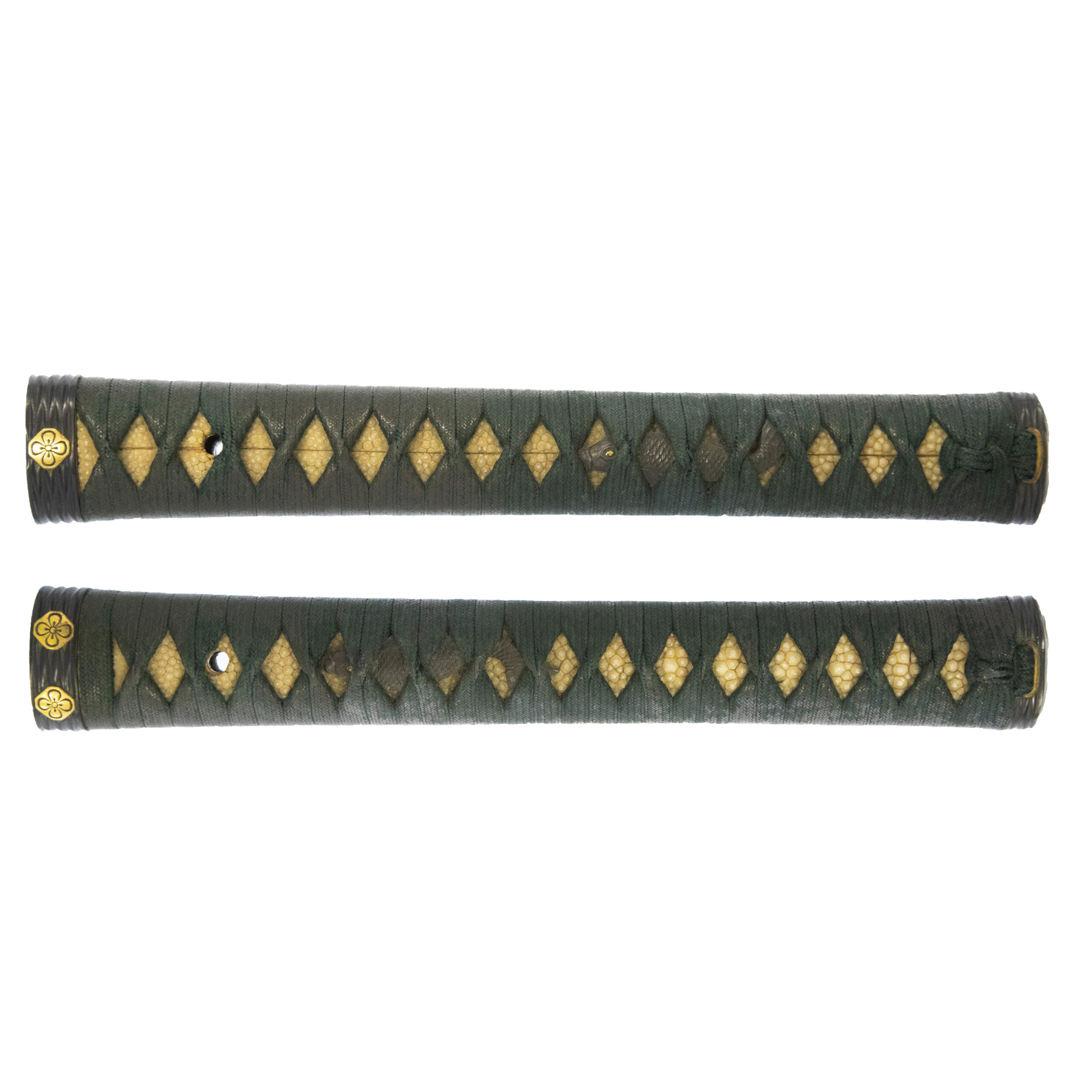
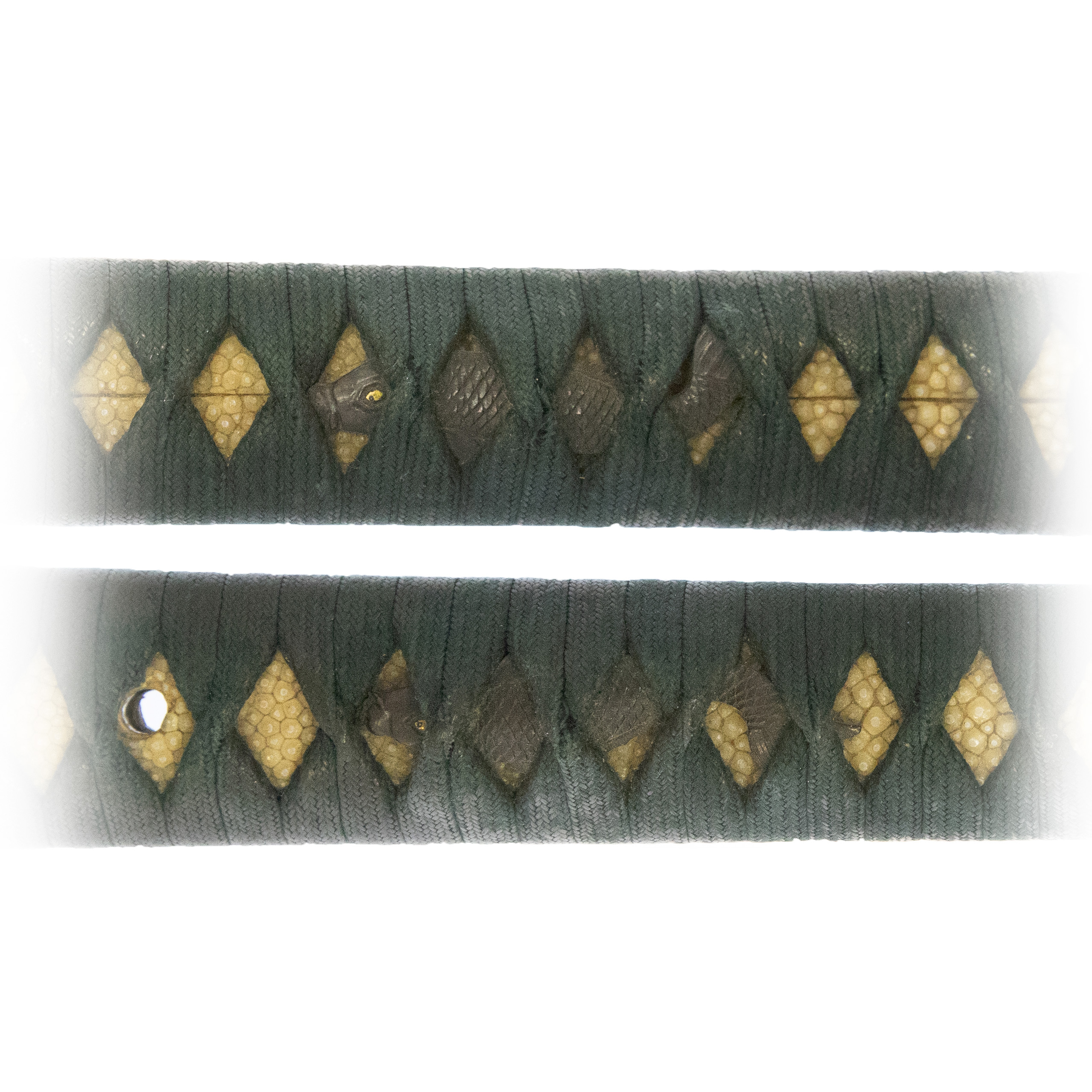
Tsuba and Habaki:Tsuba is the handguard for the Japanese Sword and Habaki is the equipment to make the blade not touch its scabbard inside. It prevents the blade from getting rusty and chipped.
A Fuji (藤, wisteria) pattern is engraved on this iron Tsuba. Such design seems to be categorized as a family crest called the Sagari-Fuji (下り藤). It depicts a round shape of a wisteria flower cluster hanging down. Since wisterias have strong fertility and grow being entwined with other trees, people regarded this flower as a symbol of longevity and prosperity for future generations.
Also, its Japanese name, Fuji (藤), is likened to another word, Fushi (不死), which means immortality. According to a theory, that is why the Fujiwara (藤原) family, who reached the height of glory in the Heian period (794-1185), used this motif for their family name and family crest. It is said there were Samurai families who used Fuji-designed family crests due to the admiration of the Fujiwara clan, which once occupied most of the upper aristocrats. Also, it might be because they wanted to share the prosperity of the Fujiwara clan. Although we cannot say for sure, this trend possibly influenced the Sagari-Fuji pattern of this Tsuba.
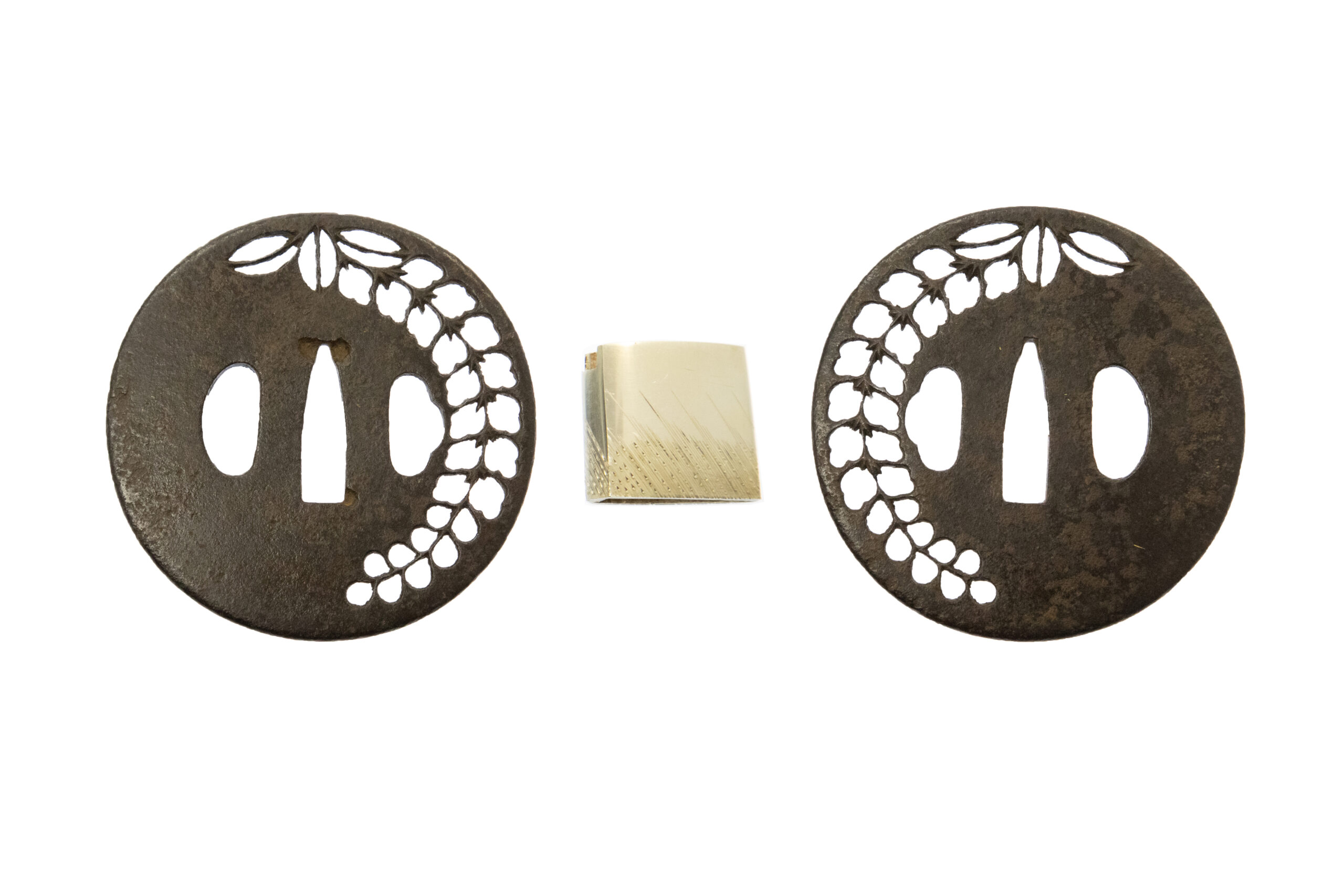
Saya: Saya is the scabbard for the Japanese sword.

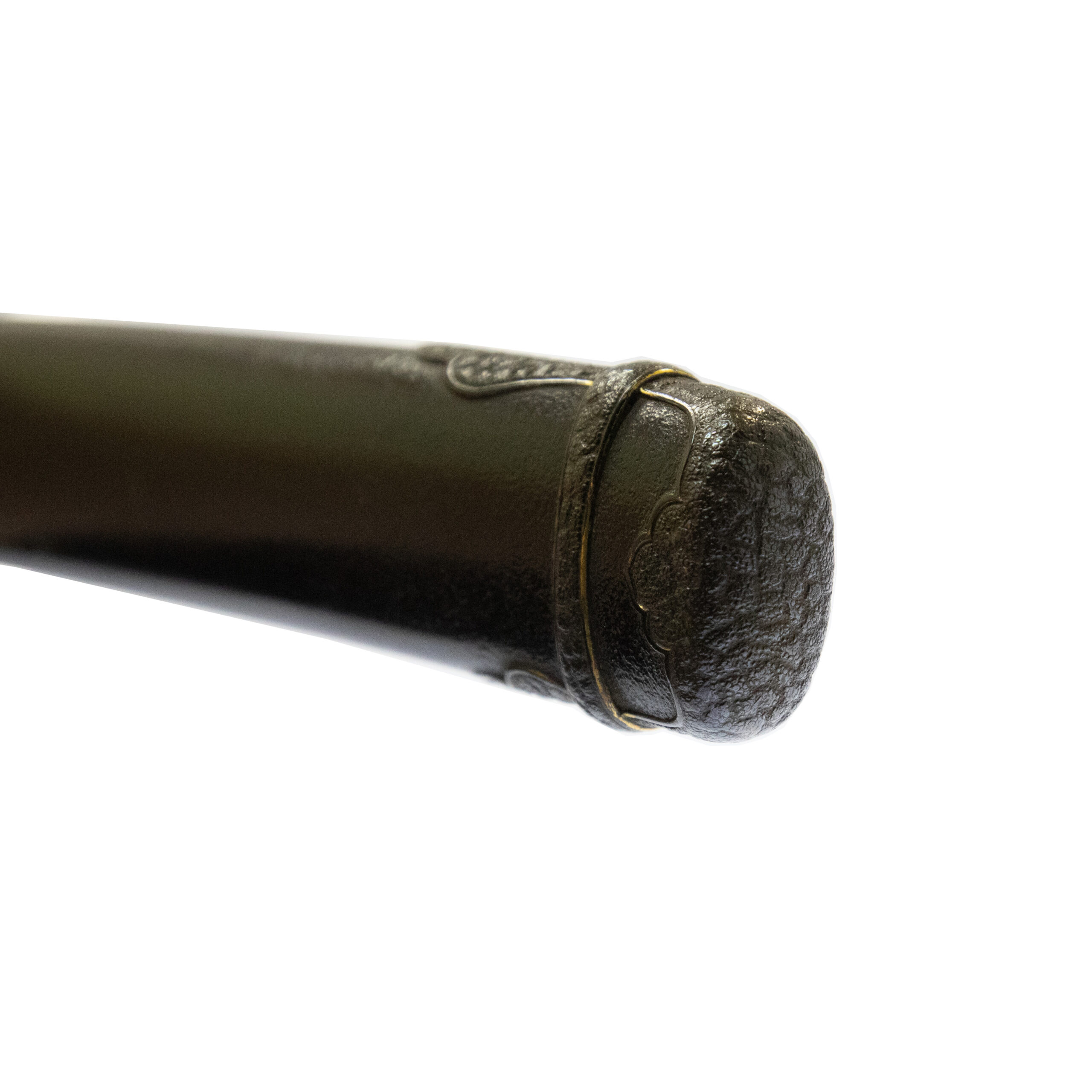
Authentication Paper:NBTHK TOKUBETSU Hozon Certificate for the blade (No. 1004733)
NBTHK, also known as Nihon Bijutsu Touken Hozon Kyokai (the Society for the Preservation of the Japan Art Sword), is one of the oldest Japanese sword appraising organizations in modern-day Japan. They authenticated the blade on Feb 4in the 28th year of Heisei (2016). They appraised it as Tokubetsu Hozon Touken, the blade especially worth preserving for Japanese society. The purchaser will receive this original certificate as well. We can also translate what is written into English and make a PDF file for your record if you request.
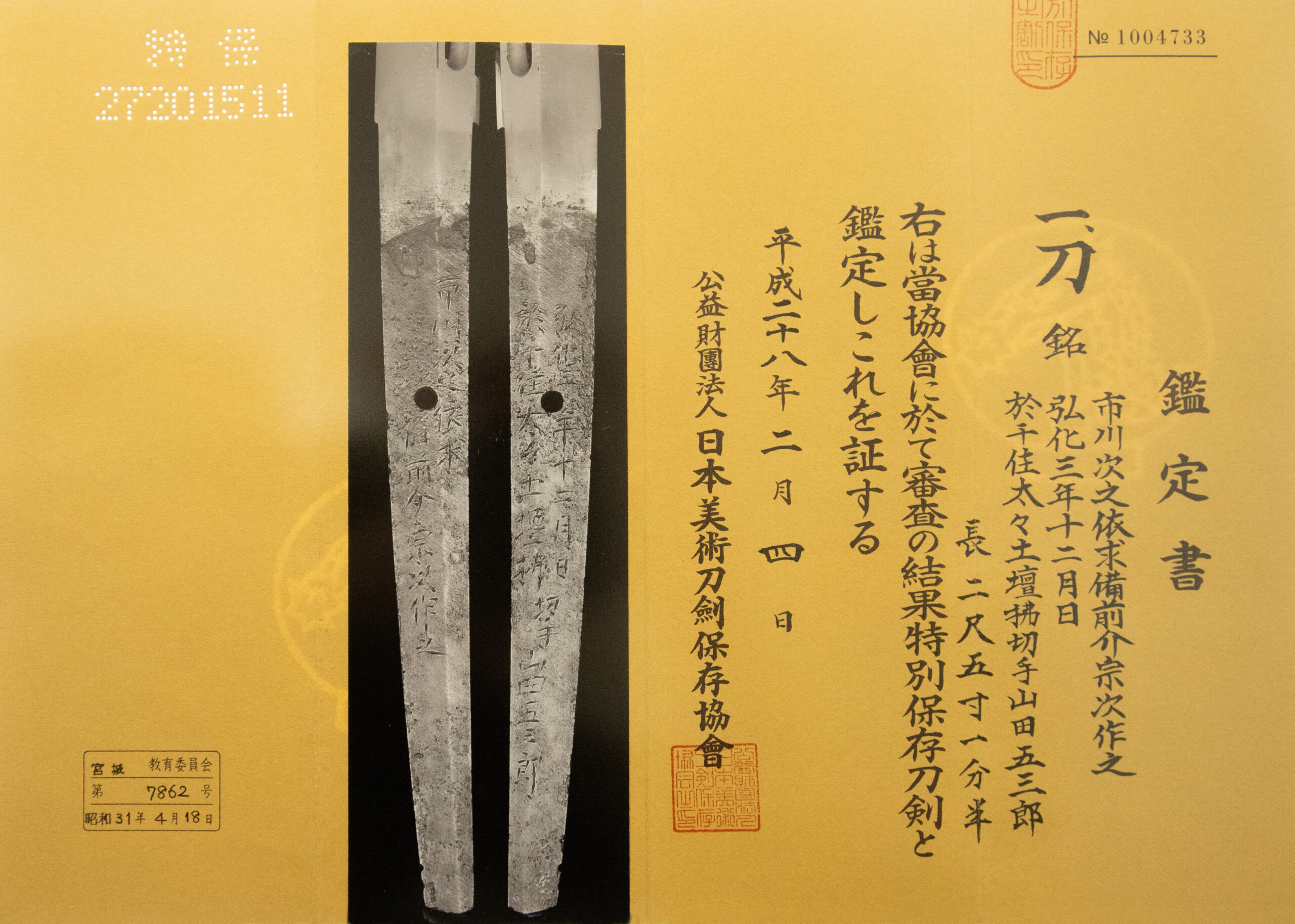
Registration Number : Miyagi 7862
The Board of Education in Miyagi prefecture issued a registration paper for this sword . It is called Jyu Token Rui Torokusho(銃刀剣類登録証). Bunkacho(The Agency for Cultural Affairs) acknowledges a Japanese sword with this paper as a work of art.
The sword needs to be traditionally hand-forged and made of Tamahagane carbon steel to be registered in the system. With this paper, its owner in Japan can legally own an authentic Japanese sword. Based on this registration number, we will apply for its export permit.
This paper will need to be returned to the board of education when the sword is being shipped abroad, but you can receive a copy of it. An English translation of this registration paper is available on request.
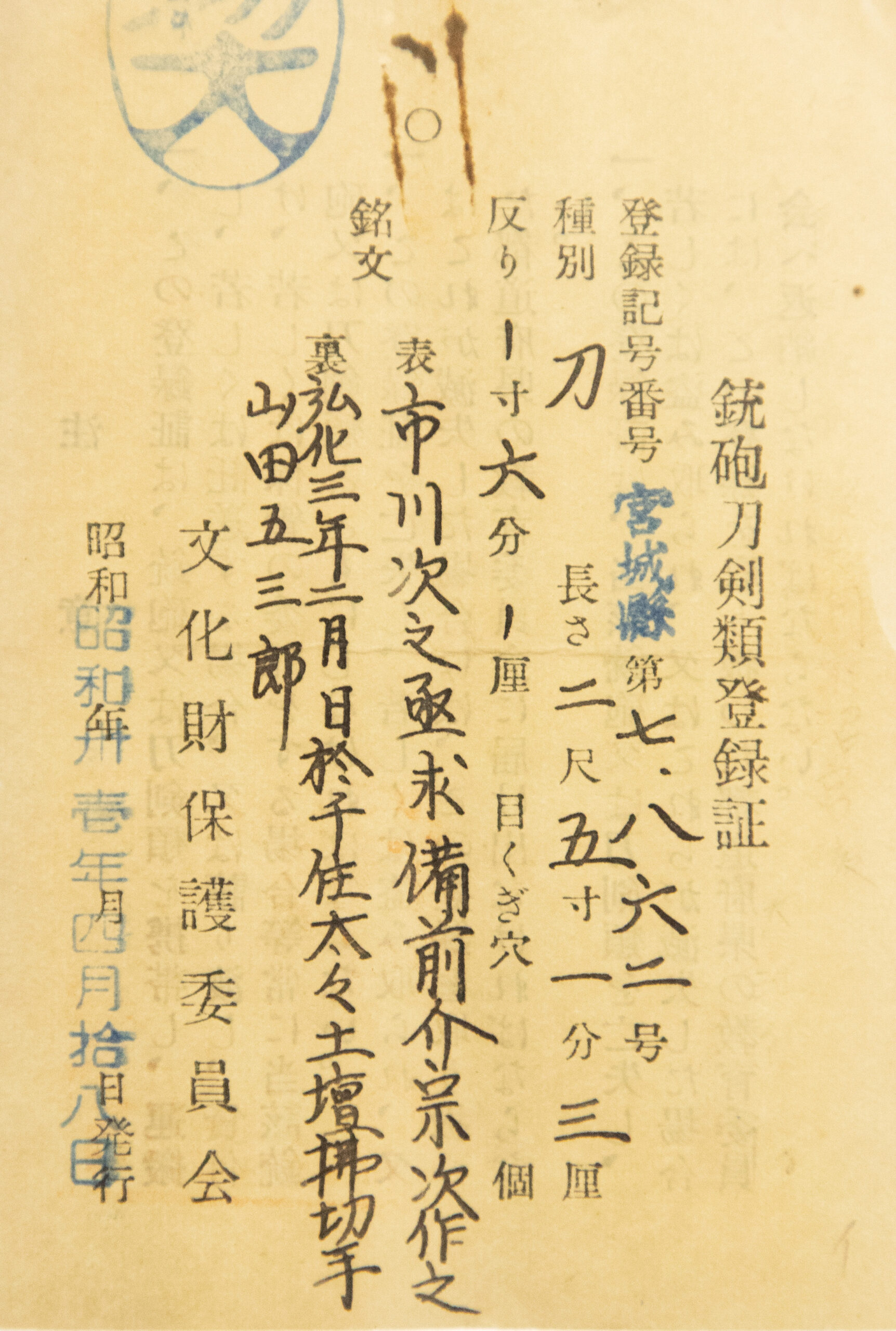
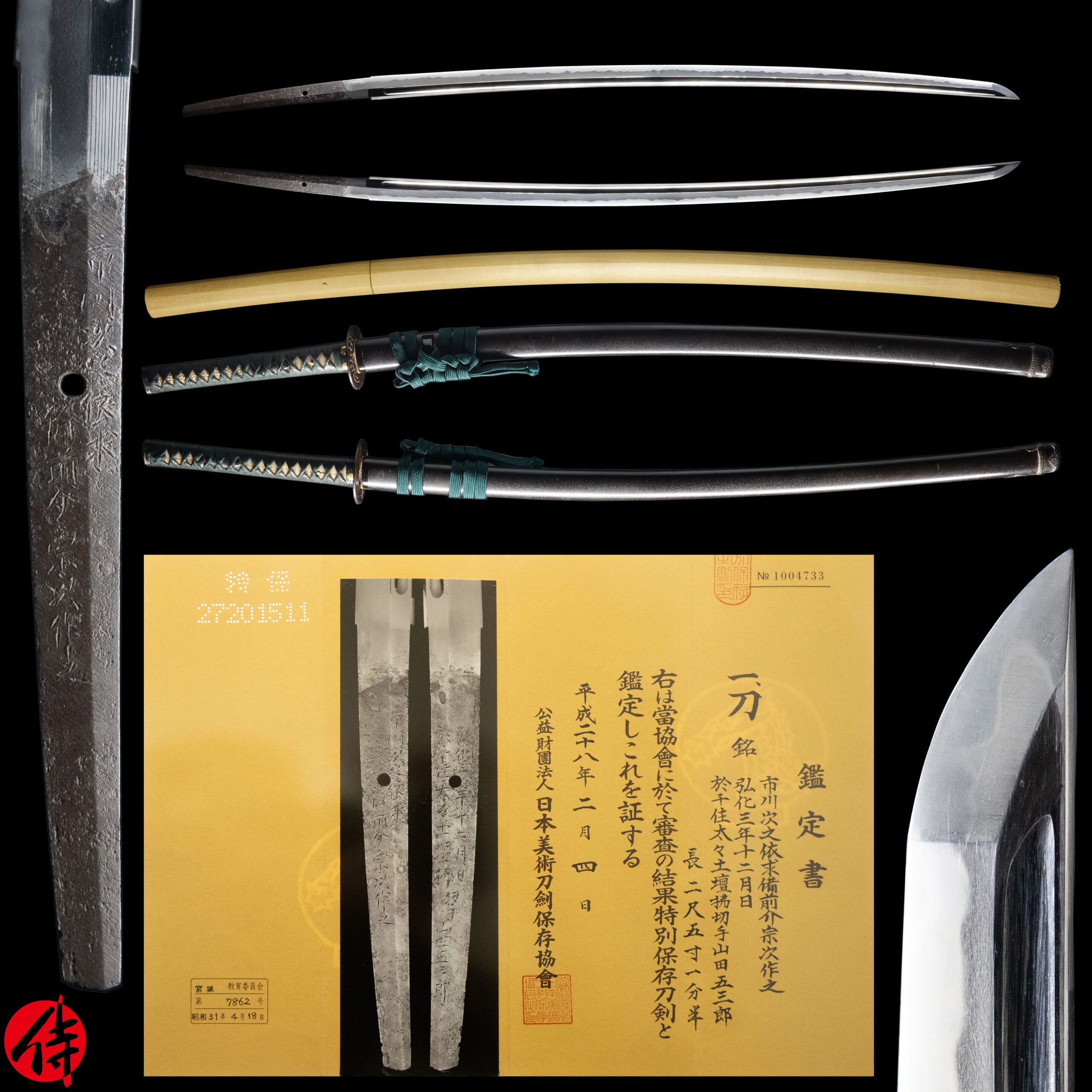
—————————————————————–
【About us】
Samurai Museum is located in Tokyo, Japan, exhibiting antique artifacts related to the Samurai history. Samurai Museum Shop is the place for those who are interested in Japanese culture and craftsmanship. We deal with antique Samurai swords/armor, traditional crafts made in Japan and so on.
【Japanese Sword& Export Process】
The Japanese swords we deal with are hand-forged edged swords made in Japan. It was made from the traditional carbon steel called TAMAHAGANE(玉鋼). Samurai Museum is familiar with the proper legal procedure for an antique/ authentic Japanese sword to be exported from Japan. We have sent more than 700 Japanese swords for the past few years (~2024) to amazing owners who appreciate its historical value.
Each Japanese sword is registered under the Agency for Cultural Affairs and the Board of Education in Japan. They issue a registration paper for each Japanese sword for its owner in Japan to legally possess it. The Japanese sword with its registration paper means it was traditionally hand-forged in Japan.
To legally export the sword from Japan to other countries, we will have to apply for its permit to the Agency for Cultural Affairs(Bunkacho) and return the original registration paper to the Board of Education. It normally takes around 2-4 weeks to receive this permit after submitting required documents. And we would like you to expect at least 1-1.5 months for your order to arrive at your given address after you ordered. For more detailed info, please click here.
It is allowed for residents in Japan to own authentic Japanese swords without a special license as long as they come with registration papers. Please feel free to contact us if you are a resident of Japan, whether temporarily or permanently. We will also assist you when you leave Japan and need to obtain an export permit. If you live in Japan, please click here before you make a purchase.
【Payment Method】
We accept payment through Stripe (Credit card), PayPal, Apple Pay or ChromePay, all of which are secure payment methods. Also, you don’t need to make an account on Stripe for the checkout. If you prefer other payment method, please contact us. After confirming your payment, we will apply for an export permit. You may either pay in JPY, USD, AUD, CAD,EUR CHF or GBP. The price is set in Japanese Yen. Prices in other currencies are automatically calculated based on the latest exchange rate.

* If the amount is above 1 million JPY, Stripe or wire transfer will be the only options for payment.
【Shipping】
We have shipped authentic Japanese swords to the USA, UK, Canada, Mexico, Germany, France, Hong Kong and Australia. If you don’t live in these countries and like to order, please contact us first before making a purchase. We offer Free International Shipping as long as we can send antique Japanese swords by EMS.
We normally ship by EMS(Express Mail Service) provided by Japan Post. We will send you a tracking number for your order as soon as we hand it to the post office. We will put 100 % insurance on the shipping document without any extra charge. Based on the total amount, there might be a duty tax or other fee for you to pay, depending on the countries. We use package cushioning to protect the item and put it in a PVC pipe, which is one of the most secure packages because of its durability.
It will normally takes 5-14 days for the item to arrive at your given address after we dispatch it. Time of delivery is estimated as accurately as possible by the carrier but does not take into account any delays beyond our control such as by inclement weather, post office holiday seasons.
* If you live in Australia and like to purchase an authentic Japanese sword, please click here to know the detail.

【Review】
Here is one of the reviews we received from a customer who purchased an authentic Japanese sword from us. For more reviews, please click here.
“My experience overall with the whole process was wonderful. I had many questions about the history and process to purchase these treasures. All my questions were answered very timely and complete. The staff is very knowledgeable and very well versed if any questions do arise.”
【How to make sure the condition】
Please keep in mind that what you are going to purchase is an antique item. We uploaded high resolution photos for you to check its condition thoroughly. If you like to see more photos with different angles, please feel free to contact us. We will be happy to send them to you so that you can make informed decision. It is essential for us to know that you are happy with your choice of a sword. and we are prepared to use the best of our ability to serve you.
【How To Contact Us】
Please contact us through email, Facebook Messenger or Live Chat if you have any questions. You can find each icon on the right side of the website. Please click one of them to reach us. We will reply to you within 1-2 business days.
【The Art of Nihonto (Japanese Sword)】
Samurai’s history is a profound, eloquent legacy of ancient Japanese warriors in which millions of people worldwide are being fascinated. If you like to find out the art of Nihonto, please click here.
【A Guide to Japanese Sword Maintenance】
After acquiring an genuine Japanese sword, it is also important to know how to take good care of it. Here is the special video for you. Mr. Paul Martin, Japanese sword expert, shows you how to give proper maintenance to your sword. By mastering how to clean the Japanese sword, its aesthetic beauty will last forever.
When you purchase a Japanese sword from us, you can get a Free Japanese sword maintenance kit. It comes with four tools(Choji Oil, Uchiko Whetstone Powder, Peg remover, Oil Applicator). By watching the video instruction above , you can enjoy learning how to maintain your Japanese sword while appreciating it. If you have any difficulty assembling the sword or cleaning the blade, you can feel free to contact us.


MORE ANTIQUE JAPANESE SWORD FOR SALE
SWORDS WITHOUT CERTIFICATES FOR SALE
LEARN JAPANESE SWORD TERMINOLOGY
Thank you for reading all the information on the page. If you have any difficulty choosing the right Japanese sword for you, we will be more than happy to help you find the one that speaks to you the most. Please feel free to contact us.


